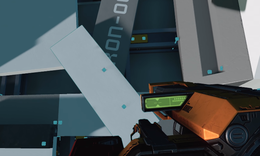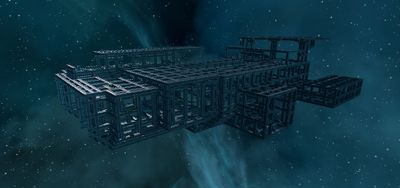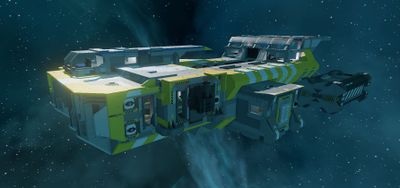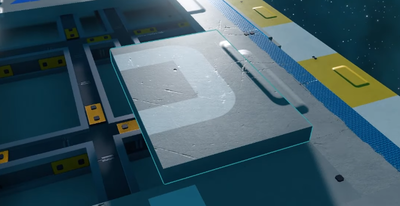Difference between revisions of "Spaceship Engineering"
| (24 intermediate revisions by 11 users not shown) | |||
| Line 1: | Line 1: | ||
{{Otherlang2 | |||
|ru=Проектирование_кораблей | |||
|fr=Spaceship_Engineering/fr | |||
|en=Spaceship Engineering | |||
|de=Spaceship Engineering:de | |||
|zh-cn=飞船工程 | |||
|ua=Проєктування кораблів | |||
}} | |||
==Summary== | ==Summary== | ||
On this page you can find detailed instructions for creating and modifying spaceships.<br> | |||
Ships can generally be constructed by manually [[Welding tool|welding]] and [[bolt tool|bolting]] objects and components together, or by manufacturing directly from a predefined blueprint.<br> | |||
Spaceships can also be bought from for example [[Origin Stations|Origin Stations]] or directly from other [[Endoskeleton|endos]]. <br> | |||
== Construction process == | |||
The ship construction process | The ship construction process from start to finish: | ||
# Mine raw resources from [[Space|asteroids]] | # Mine raw resources from [[Space|asteroids]] | ||
# Refine raw resources into usable [[Materials]] and metals. | # Refine raw resources into usable [[Materials]] and metals. | ||
# Print/Build resources into Devices | # Print and / or Build resources into Devices and Parts. | ||
# | # Weld together [[Beams]] into a usable frame (⇐ requires at least one [[Hardpoints|hardpoint]] and [[Thrusters|thruster]] bolted to it). | ||
# Bolt | ## Note: don't forget to register your ship to prevent it from despawning (easiest with the Spaceship Registration Deed). | ||
# Link required devices to power | # Bolt additional components to the frame and [[Devices and machines|Devices]]. | ||
# Link required devices to power and propellant and add control devices such as [[Levers|Levers]], [[Flight control unit|Flight control units]] and more. | |||
==Component and Device Production== | |||
[[File:Starbase_Material_inventory_icons.png|260px|thumb|Image of all currently known materials and refined ores in the galaxy]] | |||
[[File:BoltingTool_InAction.png|260px|thumb|The [[Bolt tool]] being used for emergency repairs, bolting an off angle steel plate to a frame]] | |||
All ships are created from components and devices and most objects can be bolted together using the [[Bolt tool]]. | |||
All ships are created from components and devices | |||
===[[Materials|Basic Materials]]=== | ===[[Materials|Basic Materials]]=== | ||
All Spaceships are created from refined materials collected from [[Space|asteroids]] or harvested from other ships | All Spaceships are created from refined materials collected from [[Space|asteroids]] or harvested from other ships and wrecks within the universe. | ||
Raw minerals | Raw minerals can be found throughout the universe on asteroid fields. <br> | ||
Materials and minerals will vary in distribution and usefulness, with rare minerals being used for more expensive and critical elements of ships, such as the [[Flight control unit|MFC/FCU (Flight control unit)]]. | Materials and minerals will vary in distribution and usefulness, with rare minerals being used for more expensive and critical elements of ships, such as the [[Flight control unit|MFC/FCU (Flight control unit)]]. | ||
Resources can be mined by using a [[Pickaxe]], or a [[Mining laser (Assembly)]]. | |||
===Component / Part Printing=== | ===Component / Part Printing=== | ||
Components and devices that are usable must be first printed from | Components and devices that are usable must be first printed from materials into physical objects.<br> | ||
Materials can be used to print beams, armor plates, door parts and such.<br> | |||
These printed objects and parts can be stored in Station storage. | |||
===[[Building|Basic Construction]]=== | |||
===[[Building | |||
Components in the world are primarily assembled by bolting components together using the [[Bolt tool]]. Usually the process starts from a frame that is constructed from modular beams, which functions as a frame onto which | |||
armor panels and devices can be bolted. | |||
==Ship Design== | ==Ship Design== | ||
[[File:Ithica_Superstructure.jpg|400px|thumb|Image showing the superstructure of an [[Ithaca]] | [[File:Ithica_Superstructure.jpg|400px|thumb|Image showing the superstructure of an [[Ithaca]] spaceship. Beams welded together provide the main structural backbone of a ship.]] | ||
[[File:Ithaca_LeftSide.jpg|400px|thumb|The [[Ithaca]] Spaceship after the addition of | [[File:Ithaca_LeftSide.jpg|400px|thumb|The [[Ithaca]] Spaceship after the addition of Armour Plating and various [[Devices and machines|Devices]]]] | ||
All | All spaceships need four key things to be able to function: | ||
#[[Generator | #Power & Generation ([[Generator]]) ([[Battery]]) | ||
#[[ | #Thrusters & Fuel ([[Thrusters]]) ([[Propellant]]) | ||
# | #Framing ([[Beams]]) | ||
# A method of controlling | #[[Ducts]] or cables and pipes to transfer data, electricity, propellant and heat. | ||
# A method of controlling the ship e.g. [[Levers]] which are linked to a [[Flight control unit|Flight Control Unit]] and [[Main flight computer|Main Flight Computer]]. | |||
In addition | In addition armor plating and various devices are needed to add defence, weaponry and other assorted functionality to a spaceship. | ||
During and after construction a (registered) ship can be examined with the [[Durability tool]] to test for key flaws in a design. | |||
=== | ===Superstructure / Frame=== | ||
All ships require a rigid | All ships require a rigid frame, which is the basis from which a ship's structural strength (how well it can handle stress) is derived. | ||
A | A ship's frame is composed of [[Beams]] printed from materials, which are then welded together using the [[welding tool]]. | ||
Since all structural strength is derived from a | Since all structural strength is derived from a frame, it is important that it is designed in a way that supports the ship as overpowered thrusters on a flimsy frame will tear apart a ship, and a ship without adequate support is prone to structural damage. The easiest way to lower the risk of severe structural damage from impacting an asteroid is to have a frame that can distribute stress efficiently. | ||
All structural stability of a design can be related to structural integrity. | All structural stability of a design can be related to structural integrity, which is called the Part Strength Factor. Overall ship strength is derived from the lowest part strength factor. Keep in mind that Ship Strength only needs to equal 1 - anything higher is mostly unneeded, as a frame that can distribute stress well is far better than a high strength factor. | ||
=== | ===Armour Plating=== | ||
[[File:Armour_Plate.png|400px|thumb| A small singular armour plate shown prior to being fastened into a | [[File:Armour_Plate.png|400px|thumb| A small singular armour plate shown prior to being fastened into a ship's frame]] | ||
Armour plating is the defensive skin that covers the | Armour plating is the defensive skin that covers the frame of the ship. | ||
Armour plating provides internal components and the | Armour plating provides internal components and the frame protection from [[weapons]] [[Damage]], although it is not critical to the ship's ability to fly. | ||
Armour plating is fabricated in shaped sheets or sections which can then be bolted to a | Armour plating is fabricated in shaped sheets or sections which can then be bolted to a ship's frame to add aesthetic contour and defence in critical locations to mitigate various types of [[Damage|weapons and environmental damage]]. | ||
Plating can be bolted in any location, assuming it has a valid location to be bolted | Plating can be bolted in any location, assuming it has a valid location to be bolted. It can be used for both external and internal defence and decoration. It is recommended to '''manually''' bolt plating to the frame where possible, as plates are heavy and (in the case of manual bolting) autobolting is not to everyone's taste. | ||
===[[Generator|Ship Power]]=== | ===[[Generator (Assembly)|Ship Power]]=== | ||
Almost all ships require power created from a generator device like a [[Generator (Assembly)|generator]] or [[Solar panel]]. All devices that require power need to be connected to a data network that has electricity, by the use of cables. Cables can be custom placed throughout the ship with the [[Cable tool|cable tool]]. | |||
If at any point power connection is severed the connected component or device will cease to function. | If at any point power connection is severed the connected component or device will cease to function. | ||
Ship generators are not simple plug and play devices, and can use a whole host of additional addon-devices that facilitate it's function | Ship generators are not simple plug and play devices, and can use a whole host of additional addon-devices that facilitate it's function. <br> | ||
* | Generators need to have: | ||
* | * Cooling / heat dispersion (radiators, coolant cells, heatsinks, passive cooling) | ||
* Fuel | * Power Output (generator socket) | ||
* Fuel (Fuelchamber with fuel rod) | |||
**'''Note:''' tier 1 fuel rods, generators and fuelchambers don't work in combination with higher tiers | |||
===[[Thrusters|Thrusters/Thrust]]=== | ===[[Thrusters|Thrusters/Thrust]]=== | ||
Thrusters are devices that provide the main driving force of a spaceship in flight. | Thrusters are devices that provide the main driving force of a spaceship in flight. | ||
Every ship requires thrusters to fly in space and provide motion in all axis for the spaceship. | Every ship requires thrusters to fly in space and to provide motion in all axis for the spaceship. | ||
Thrusters require both power | Thrusters require both power and [[Propellant]] to be able to function. | ||
The exact amount | The exact amount required depends on the thruster type and activity of the thruster (at 0 activity, no resource is used). | ||
[[Propellant]] is stored in [[Propellant tank|tanks]] within the ship. | |||
Every thruster needs | Every thruster needs direct connection to a propellant tank to facilitate its use, connected through use of the [[Pipe tool]] or [[Ducts|Duct]]. | ||
Cessation of | Cessation of propellant supply, by disconnect or other, will cause a thruster to cease functioning. | ||
Most ships | Most small ships require multiple small maneuvering thrusters in all directions, this provides a ship the ability to turn and point itself when travelling. Larger ships will often use triangle thrusters, as they produce many times the amount of thrust of manuvouring thrusters. | ||
In Starbase all thrusters apply a torque around the centre of mass, | In Starbase all thrusters apply a torque around the centre of mass, and stress to the frame from where the hardpoint is bolted. Thus, for the most efficient designs, thrust should be balanced and equally distributed as much as possible. | ||
===[[Flight control unit|MFC/FCU (Flight control unit)]]=== | ===[[Flight control unit|MFC/FCU (Flight control unit)]]=== | ||
The 'Main Flight Computer'([[Main flight computer|MFC]]) and 'Flight Control Unit'([[Flight control unit|FCU]]) are devices used to 'balance' a ship. They are not strictly necessary, but help out a lot. | |||
The | For example in a ship which has offset thrusters, or has damaged thrusters on one side of the ship, under normal circumstances accelerating will cause the ship to spiral out of control. The FCU/MFC combination will try to balance the ship as good as they can with the thrusters they have access to. | ||
FCU'and MFC's come in the form of small boxes, and can usually be easily identified on a build. | |||
All FCU's will take input from various control means and route into a central MFC (connected via cables), which combines information from possibly two FCU's and sends data to the thrusters it is connected to in order to balance them. | |||
The FCU/MFC will throttle each thruster so that forces around the center of mass are balanced and thus when accelerating, even if the ship is off balance or has battle damage, the ship will not spiral out of control and it will still be (easily) flyable, even when subject to battle damage. | |||
MFCs can only be connected to a limited amount of thrusters, so it might be necessary to either add more MFCs ('''NOTE:''' MFCs don't communicate so they can work against each other) or combine thrusters (setting their device field to the same name/address). | |||
Being | Being components that have such a high importance they are a great component to be looted or targeted, and should be kept heavily defended. | ||
===[[Devices and machines|Additional Devices]]=== | ===[[Devices and machines|Additional Devices]]=== | ||
[[Devices and machines|Additional Devices]] on a ship | [[Devices and machines|Additional Devices]] on a ship refer to the many additional components that can be attached to a ship that provide additional functionality.<br> | ||
Devices include but are not limited to: [[Weapons]], [[Devices and machines| | Devices include but are not limited to: [[Weapons]], [[Devices and machines|Devices and Machines]] such as doors, [[generator|generators]], control seats, [[Mining laser (Assembly)|mining equipment]] and such. | ||
Devices require | Most Devices require to be connected to power and usually fastened to the frame, like the armor plating. | ||
Critical out of these is a controlling device that facilitates a characters ability to interface with and control a ship | Critical out of these is a controlling device that facilitates a characters ability to interface with and control a ship. | ||
This can be in the form of [[Ship controls|directional levers or buttons around the ship, or in a command centre or bridge.]] | This can be in the form of [[Ship controls|directional levers or buttons around the ship, or in a command centre or bridge.]] | ||
In addition | In addition, almost all devices have some form of access to the programming language [[YOLOL]], which ultimately allows automation of processes and streamlining of ship systems for enhanced functionality. | ||
Latest revision as of 14:38, 11 December 2023
Summary
On this page you can find detailed instructions for creating and modifying spaceships.
Ships can generally be constructed by manually welding and bolting objects and components together, or by manufacturing directly from a predefined blueprint.
Spaceships can also be bought from for example Origin Stations or directly from other endos.
Construction process
The ship construction process from start to finish:
- Mine raw resources from asteroids
- Refine raw resources into usable Materials and metals.
- Print and / or Build resources into Devices and Parts.
- Weld together Beams into a usable frame (⇐ requires at least one hardpoint and thruster bolted to it).
- Note: don't forget to register your ship to prevent it from despawning (easiest with the Spaceship Registration Deed).
- Bolt additional components to the frame and Devices.
- Link required devices to power and propellant and add control devices such as Levers, Flight control units and more.
Component and Device Production

All ships are created from components and devices and most objects can be bolted together using the Bolt tool.
Basic Materials
All Spaceships are created from refined materials collected from asteroids or harvested from other ships and wrecks within the universe.
Raw minerals can be found throughout the universe on asteroid fields.
Materials and minerals will vary in distribution and usefulness, with rare minerals being used for more expensive and critical elements of ships, such as the MFC/FCU (Flight control unit).
Resources can be mined by using a Pickaxe, or a Mining laser (Assembly).
Component / Part Printing
Components and devices that are usable must be first printed from materials into physical objects.
Materials can be used to print beams, armor plates, door parts and such.
These printed objects and parts can be stored in Station storage.
Basic Construction
Components in the world are primarily assembled by bolting components together using the Bolt tool. Usually the process starts from a frame that is constructed from modular beams, which functions as a frame onto which armor panels and devices can be bolted.
Ship Design

All spaceships need four key things to be able to function:
- Power & Generation (Generator) (Battery)
- Thrusters & Fuel (Thrusters) (Propellant)
- Framing (Beams)
- Ducts or cables and pipes to transfer data, electricity, propellant and heat.
- A method of controlling the ship e.g. Levers which are linked to a Flight Control Unit and Main Flight Computer.
In addition armor plating and various devices are needed to add defence, weaponry and other assorted functionality to a spaceship. During and after construction a (registered) ship can be examined with the Durability tool to test for key flaws in a design.
Superstructure / Frame
All ships require a rigid frame, which is the basis from which a ship's structural strength (how well it can handle stress) is derived. A ship's frame is composed of Beams printed from materials, which are then welded together using the welding tool.
Since all structural strength is derived from a frame, it is important that it is designed in a way that supports the ship as overpowered thrusters on a flimsy frame will tear apart a ship, and a ship without adequate support is prone to structural damage. The easiest way to lower the risk of severe structural damage from impacting an asteroid is to have a frame that can distribute stress efficiently.
All structural stability of a design can be related to structural integrity, which is called the Part Strength Factor. Overall ship strength is derived from the lowest part strength factor. Keep in mind that Ship Strength only needs to equal 1 - anything higher is mostly unneeded, as a frame that can distribute stress well is far better than a high strength factor.
Armour Plating
Armour plating is the defensive skin that covers the frame of the ship. Armour plating provides internal components and the frame protection from weapons Damage, although it is not critical to the ship's ability to fly.
Armour plating is fabricated in shaped sheets or sections which can then be bolted to a ship's frame to add aesthetic contour and defence in critical locations to mitigate various types of weapons and environmental damage. Plating can be bolted in any location, assuming it has a valid location to be bolted. It can be used for both external and internal defence and decoration. It is recommended to manually bolt plating to the frame where possible, as plates are heavy and (in the case of manual bolting) autobolting is not to everyone's taste.
Ship Power
Almost all ships require power created from a generator device like a generator or Solar panel. All devices that require power need to be connected to a data network that has electricity, by the use of cables. Cables can be custom placed throughout the ship with the cable tool. If at any point power connection is severed the connected component or device will cease to function.
Ship generators are not simple plug and play devices, and can use a whole host of additional addon-devices that facilitate it's function.
Generators need to have:
- Cooling / heat dispersion (radiators, coolant cells, heatsinks, passive cooling)
- Power Output (generator socket)
- Fuel (Fuelchamber with fuel rod)
- Note: tier 1 fuel rods, generators and fuelchambers don't work in combination with higher tiers
Thrusters/Thrust
Thrusters are devices that provide the main driving force of a spaceship in flight. Every ship requires thrusters to fly in space and to provide motion in all axis for the spaceship. Thrusters require both power and Propellant to be able to function. The exact amount required depends on the thruster type and activity of the thruster (at 0 activity, no resource is used).
Propellant is stored in tanks within the ship. Every thruster needs direct connection to a propellant tank to facilitate its use, connected through use of the Pipe tool or Duct. Cessation of propellant supply, by disconnect or other, will cause a thruster to cease functioning.
Most small ships require multiple small maneuvering thrusters in all directions, this provides a ship the ability to turn and point itself when travelling. Larger ships will often use triangle thrusters, as they produce many times the amount of thrust of manuvouring thrusters.
In Starbase all thrusters apply a torque around the centre of mass, and stress to the frame from where the hardpoint is bolted. Thus, for the most efficient designs, thrust should be balanced and equally distributed as much as possible.
MFC/FCU (Flight control unit)
The 'Main Flight Computer'(MFC) and 'Flight Control Unit'(FCU) are devices used to 'balance' a ship. They are not strictly necessary, but help out a lot.
For example in a ship which has offset thrusters, or has damaged thrusters on one side of the ship, under normal circumstances accelerating will cause the ship to spiral out of control. The FCU/MFC combination will try to balance the ship as good as they can with the thrusters they have access to.
FCU'and MFC's come in the form of small boxes, and can usually be easily identified on a build. All FCU's will take input from various control means and route into a central MFC (connected via cables), which combines information from possibly two FCU's and sends data to the thrusters it is connected to in order to balance them. The FCU/MFC will throttle each thruster so that forces around the center of mass are balanced and thus when accelerating, even if the ship is off balance or has battle damage, the ship will not spiral out of control and it will still be (easily) flyable, even when subject to battle damage.
MFCs can only be connected to a limited amount of thrusters, so it might be necessary to either add more MFCs (NOTE: MFCs don't communicate so they can work against each other) or combine thrusters (setting their device field to the same name/address).
Being components that have such a high importance they are a great component to be looted or targeted, and should be kept heavily defended.
Additional Devices
Additional Devices on a ship refer to the many additional components that can be attached to a ship that provide additional functionality.
Devices include but are not limited to: Weapons, Devices and Machines such as doors, generators, control seats, mining equipment and such.
Most Devices require to be connected to power and usually fastened to the frame, like the armor plating.
Critical out of these is a controlling device that facilitates a characters ability to interface with and control a ship. This can be in the form of directional levers or buttons around the ship, or in a command centre or bridge.
In addition, almost all devices have some form of access to the programming language YOLOL, which ultimately allows automation of processes and streamlining of ship systems for enhanced functionality.

